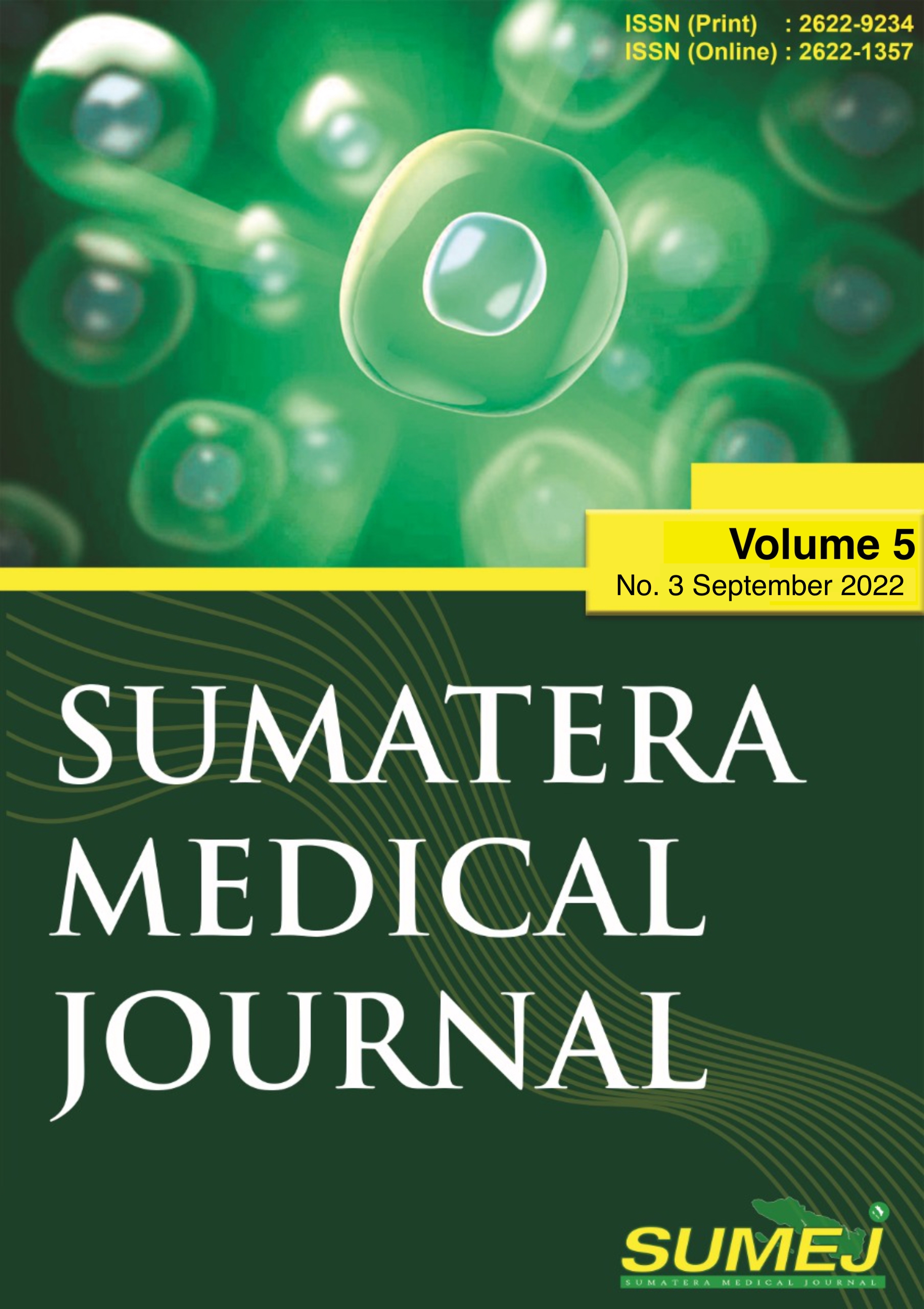The Relationship between Diabetic Retinopathy Degree with Visual Acuity and Retinal Nerve Fiber Layer Thickness in Type 2 Diabetes Mellitus Patients
DOI:
https://doi.org/10.32734/sumej.v5i3.9190Keywords:
Keywords: Diabetic Retinopathy, Diabetes Mellitus, Retinal Nerve Fiber LayerAbstract
Introduction: Diabetic retinopathy is an ocular complication of diabetes mellitus (DM), and is one of the leading causes of visual impairment and blindness worldwide.. More than one third of people with diabetes have signs of diabetic retinopathy.
Methods: This was an analytic observational study with cross-sectional design. The sample was type 2 diabetes mellitus patients with diabetic retinopathy who visited the eye clinic at the University of Sumatera Utara General Hospital from September 2021-December 2021. The sample were then analyzed with the Mann-Whitney and Kruskal Wallis test to find the relationship between diabetic retinopathy degree with visual acuity and retinal nerve fiber layer thickness in type 2 diabetes mellitus patients.
Results: The sample of this study were 20 subjects with diabetic retinopathy and 20 subjects without diabetic retinopathy as the control group. The mean visual acuity in subjects with mild diabetic retinopathy was 0.65+0.48. Average visual acuity in subjects with the degree of moderate diabetic retinopathy was 0.83+0.46. The mean visual acuity in subjects with a proliferative degrees diabetic retinopathy was 0.77+0.64. Mann Whitney test revealed no statistically significant relationship between the degree of diabetic retinopathy and visual acuity (p=0.734). Using the Kruskal Wallis test revealed that there was no significant relationship between the degree of retinopathy diabetic with Avg RNFL (p=0.495), superior RNFL (p=0.385), inferior RNFL (p=0.111), temporal RNFL (p=0.064), nasal RNFL (p=0.535).
Discussion: Controlling blood glucose levels becomes more important than the duration of diabetes in preventing the development of retinopathy. Most patients are advised to have an HbA1c of 7% or lower, and for certain patients it is recommended to be lower than6.5%. Diabetic retinopathy slowly damages the retinal blood vessels or the optic nerve layer, leading to leakage, thus resulting in accumulation of fluid containing lipid and blood in the retina which will gradually lead to visual impairment, and even blindness.
Conclusion: There is no significant relationship between diabetic retinopathy degree with visual acuity and retinal nerve fiber layer thickness in type 2 diabetes mellitus patients.
Downloads
References
International Diabetes Foundation. IDF Diabetes Atlas. Edisi ke-8. International Diabetes Federation; 2017.
World Heatlh Organization. Global report on diabetes. Edisi 2016. France: World Health Organization;
Lee R, Wong TY, Sabanayagam C. Epidemiology of diabetic retinopathy, diabetic macular edema and related vision loss. Eye Vis. 2015 Dec;2(1).
Flaxman SR, Bourne RRA, Resnikoff S, Ackland P, Braithwaite T, Cicinelli MV, et al. Global causes of blindness and distance vision impairment 1990– 2020: a systematic review and meta- analysis. Lancet Glob Health. 2017 Dec 1;5(12):e1221–34.
International Council of Ophthalmology. Update 2017 ICO Guidelines for Diabetic Eye Care. Int Counc Ophthalmol. 2017;1–34.
Didik Budijanto, Rudy Kurniawan, Kurniasih N, Khairani. InfoDatin : Hari Diabetes Sedunia tahun 2018. Kementeri Kesehat RI Pus Data Dan Inf. 2018;1–8.
Liu L, Wang Y, Liu HX, Gao J. Peripapillary Region Perfusion and Retinal Nerve Fiber Layer Thickness Abnormalities in Diabetic Retinopathy Assessed by OCT Angiography. Translational vision science & technology. 2019;8(4):1- 9.
Sasongko MB, Widyaputri F, Agni AN, Wardhana FS, Kotha S, Gupta P, Widayanti TW, Haryanto S, Widyaningrum R, Wong TY, Kawasaki R. Prevalence of diabetic retinopathy and blindness in Indonesian adults with type 2 diabetes. American journal of ophthalmology. 2017;181:79-87.
Chen X, Nie C, Gong Y, Zhang Y, Jin X, Wei S, Zhang M. Peripapillary retinal nerve fiber layer changes in preclinical diabetic retinopathy: a meta- analysis. PloS one. 2015;10(5):e0125919.
Liu L, Wang Y, Liu HX, Gao J. Peripapillary Region Perfusion and Retinal Nerve Fiber Layer Thickness Abnormalities in Diabetic Retinopathy Assessed by OCT Angiography. Translational vision science & technology. 2019;8(4):1- 9.
She X, Guo J, Liu X, Zhu H, Li T, Zhou M, Wang F, Sun X. Reliability of vessel density measurements in the peripapillary retina and correlation with retinal nerve fiber layer thickness in healthy subjects using optical coherence tomography angiography. Ophthalmologica. 2018;240(4):183-90.
American Academy of Ophthalmology. Basic and Clinical Science Course : Retina and Vitreous. American Academy of Ophthalmology; 2016.
Nadia K. Waheed, Amir H. Kashani, Carlos Alexandre de Amorim Garcia Filho, Jay S. Duker, Philip J. Rosenfeld. Retinal Imaging and Diagnostics : Optical Coherence Tomography. In: Ryan’s Retina. edisi 6. China: Elsevier Inc; 2018. 77–9, 102–6.
Qi ZH, Li YW, Na WX, Sheng YQ, Di CZ, Chen XI, Yu ZM, Jun LD, Yang WZ, Wei CH, Feng LY. Repeatability and reproducibility of quantitative assessment of the retinal microvasculature using optical coherence tomography angiography based on optical microangiography. Biomedical and Environmental Sciences. 2018;31(6):407-12.
Chen CL, Bojikian KD, Xin C, Wen JC, Gupta D, Zhang Q, Mudumbai RC, Johnstone MA, Chen PP, Wang RK. Repeatability and reproducibility of optic nerve head perfusion measurements using optical coherence tomography angiography. Journal of biomedical optics. 2016;21(6):065002.
American Academy of Ophthalmology. Basic and Clinical Science Course : Fundamentals and Principles of Ophthalmology. American Academy of Ophthalmology; 2016.
Vujosevic S, Muraca A, Gatti V, Masoero L, Brambilla M, Cannillo B, Villani E, Nucci P, DeCillà S. Peripapillary microvascular and neural changes in diabetes mellitus: an OCT-Angiography study. Investigative Ophthalmology & Visual Science. 2018;59(12):5074-81.
Mase T, Ishibazawa A, Nagaoka T, Yokota H, Yoshida A. Radial peripapillary capillary network visualized using wide-field montage optical coherence tomography angiography. Investigative ophthalmology & visual science. 2016;57(9):504-10.
Cao D, Yang D, Yu H, Xie J, Zeng Y, Wang J, Zhang L. Optic nerve head perfusion changes preceding peripapillary retinal nerve fibre layer thinning in preclinical diabetic retinopathy. Clinical & experimental ophthalmology. 2019;47(2):219-25.
Barber AJ. Diabetic retinopathy: recent advances towards understanding neurodegeneration and vision loss. Science China Life Sciences. 2015;58(6):541-9.
Victor AA. Optic Nerve Changes in Diabetic Retinopathy. IntechOpen. 2018:85-103.
Carmen A. Puliafito, Michael R. Hee, Joel S. Schuman, James G. Fujimoto. Optical Coherence Tomography of Ocular Diseases. edisi 3. Slack Incorporated; 2012.
CIRRUS HD-OCT from ZEISS : How to read the reports. Dublin, USA: Carl Zeiss Meditec, Inc.
Yang HS, Woo JE, Kim M, Kim DY, Yoon YH. Co-Evaluation of Peripapillary RNFL Thickness and Retinal Thickness in Patients with Diabetic Macular Edema: RNFL Misinterpretation and Its Adjustment. Plos One. 2017;12:1–13.
Shi R, Guo Z, Wang F, Li R, Lin R, Zhao L. Alterations in retinal nerve fiber layer thickness in early stages of diabetic retinopathy and potential risk factors. Curr Eye Res. 2017;1–10.
El-Hifnawy MAM, Sabry KM, Gomaa AR, Hassan TA. Effect of diabetic retinopathy on retinal nerve fiber layer thickness. Delta J Ophthalmol. 2016;17:162–6.
Yu J, Gu R, Zong Y, Xu H, Wang X, Sun X, Jiang C, Xie B, Jia Y, Huang D. Relationship between retinal perfusion and retinal thickness in healthy subjects: an optical coherence tomography angiography study. Investigative ophthalmology & visual science. 2016;57(9):204-10.
Agemy SA, Scripsema NK, Shah CM, Chui T, Garcia PM, Lee JG, Gentile RC, Hsiao YS, Zhou Q, Ko T, Rosen RB. Retinal vascular perfusion density mapping using optical coherence tomography angiography in normals and diabetic retinopathy patients. Retina. 2015;35(11):2353-63.
Ivania P, Stephanie W, Stephan H, Georg F, Clemens V, Hemma R. Compensation for Retinal Vessel Density Reduces the Variation of Circumpapillary RNFL in Healthy Subjects. Plos One. 2015;1-10.
Terrance Siew. Cirrus Ver 11 : Angioplex for the Optic Nerve Head. Zeiss.
Downloads
Published
How to Cite
Issue
Section
License
Copyright (c) 2022 Sumatera Medical Journal

This work is licensed under a Creative Commons Attribution-NonCommercial-NoDerivatives 4.0 International License.
The Authors submitting a manuscript do so on the understanding that if accepted for publication, copyright of the article shall be assigned to Sumatera Medical Journal (SUMEJ) and Faculty of Medicine as well as TALENTA Publisher Universitas Sumatera Utara as publisher of the journal.
Copyright encompasses exclusive rights to reproduce and deliver the article in all form and media. The reproduction of any part of this journal, its storage in databases and its transmission by any form or media, will be allowed only with a written permission from Sumatera Medical Journal (SUMEJ).
The Copyright Transfer Form can be downloaded here.
The copyright form should be signed originally and sent to the Editorial Office in the form of original mail or scanned document.











